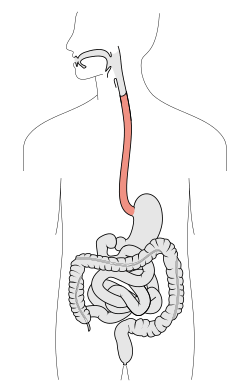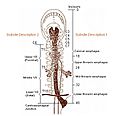Esophagus facts for kids
Quick facts for kids Esophagus |
|
|---|---|
 |
|
| The digestive tract, with the esophagus marked in red | |
| Latin | Oesophagus |
| System | Part of the digestive system |
| Artery | Oesophageal arteries |
| Vein | Oesophageal veins |
| Nerve | Sympathetic trunk, vagus |
| Precursor | Foregut |
The esophagus (say: ee-SOF-uh-gus), also known as the gullet, is a very important tube inside your body. It's part of your digestive system. This tube connects your pharynx (the back of your throat) to your stomach. It's like a special pathway for food and drinks.
Your esophagus is about 25 centimeters (10 inches) long. It's lined with strong muscles. These muscles work together to push food down into your stomach.
Contents
How Your Esophagus Works
The esophagus has a special job: moving food from your mouth to your stomach. It does this using a cool process called peristalsis.
What is Peristalsis?
When you swallow food, the muscles in your esophagus squeeze and relax in a wave-like motion. This wave pushes the food down, much like squeezing toothpaste out of a tube. This muscular movement is called peristalsis. It makes sure food only goes one way – down!
The Esophageal Sphincter
At the very end of your esophagus, right before your stomach, there's a ring of muscle. This muscle is called a sphincter. Think of it like a gate. Most of the time, this gate is closed. This stops stomach acid from coming back up into your esophagus.
When food or drink comes down the esophagus, the sphincter muscle relaxes. This opens the gate, allowing the food to enter your stomach. Once the food is in, the gate closes again.
Food in the Stomach
After food enters your stomach, it gets churned and mixed. Your stomach adds special juices to it. This turns the food into a thick, soupy mixture. This mixture is called chyme (say: kime). From there, the chyme moves into your small intestine for more digestion.
Images for kids
See also
 In Spanish: Esófago para niños
In Spanish: Esófago para niños


